Abstract
Seasonal changes in IgE antibodies and their relationship to IgG antibodies were studied in 52 patients with ragweed hay fever and 10 normal controls. Allergic patients received either no immunotherapy, preseasonal immunotherapy, or high dose perennial immunotherapy with aqueous-mixed ragweed extract. Serums were collected before, during, just after, and 4 mo after the ragweed pollination season. IgE antibodies to ragweed antigen E (AgE) were measured using the radioallergosorbent test, and IgG antibodies were measured by radioimmunoprecipitation.
IgE antibodies to AgE were elevated in all allergic patients, and rose during the ragweed pollination season. The magnitude of the rise in IgE antibody was a function of the preseasonal IgE antibody level. IgE antibody production in the treated groups was the same as in the untreated group when patients were matched on the basis of their preseasonal IgE antibody levels. Thus, we were not able to confirm previous reports that immunotherapy suppresses the seasonal rise in IgE antibodies. Furthermore, there was a close relationship between the levels of IgE and IgG antibodies in the high dose group. This finding is contrary to what one would expect were IgG antibodies acting to suppress the formation of IgE antibodies. Rather, it suggests that in certain patients either humoral immunological reactivity to ragweed antigens in the IgG and IgE classes is low to begin with or that this reactivity may wane after treatment with high doses of ragweed extract.
Full text
PDF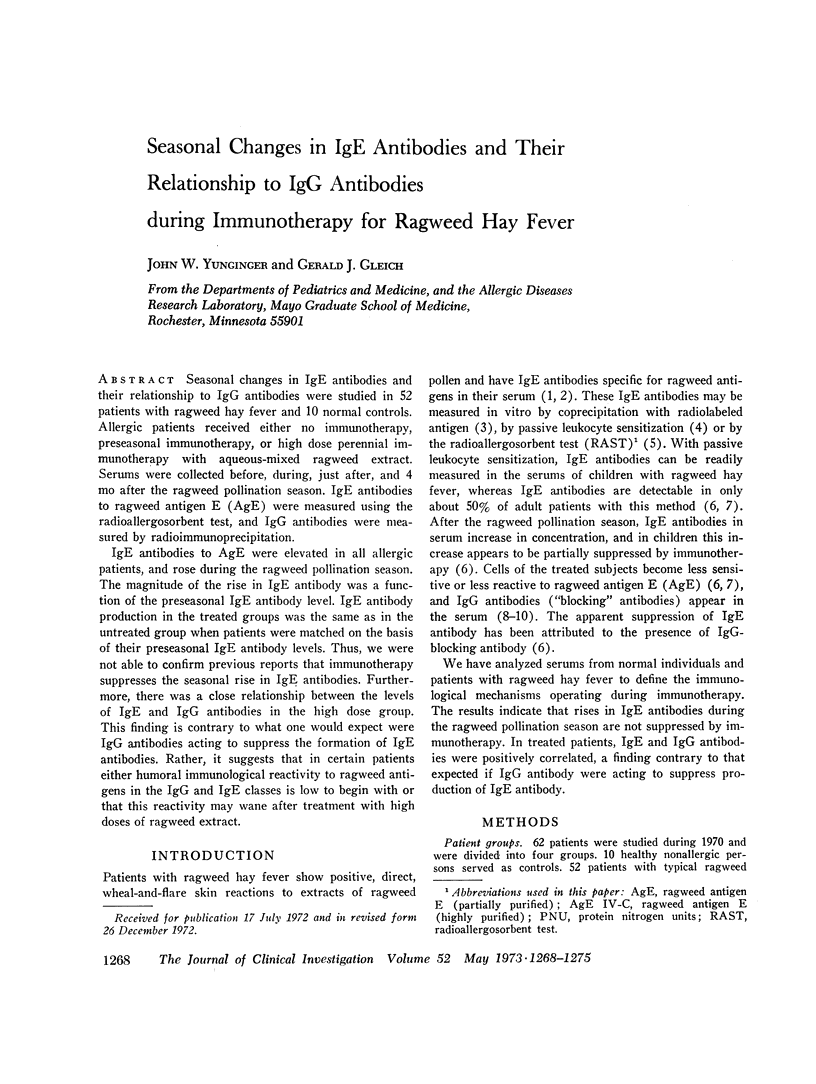
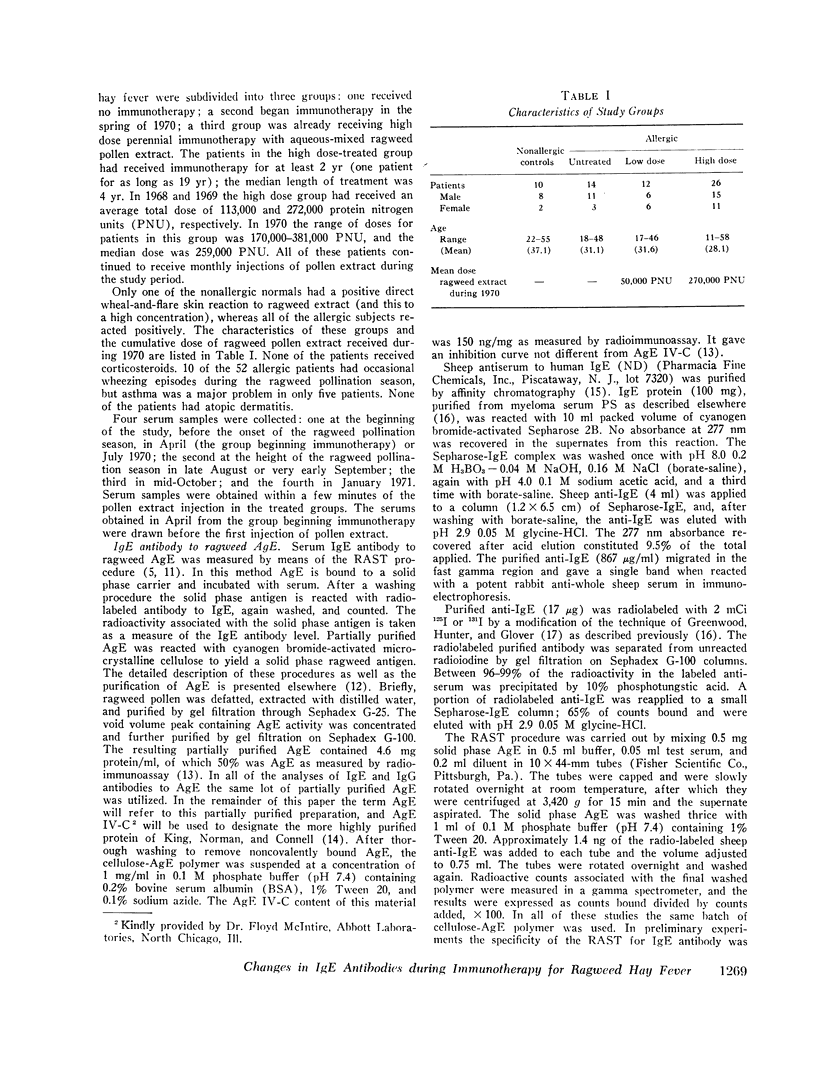
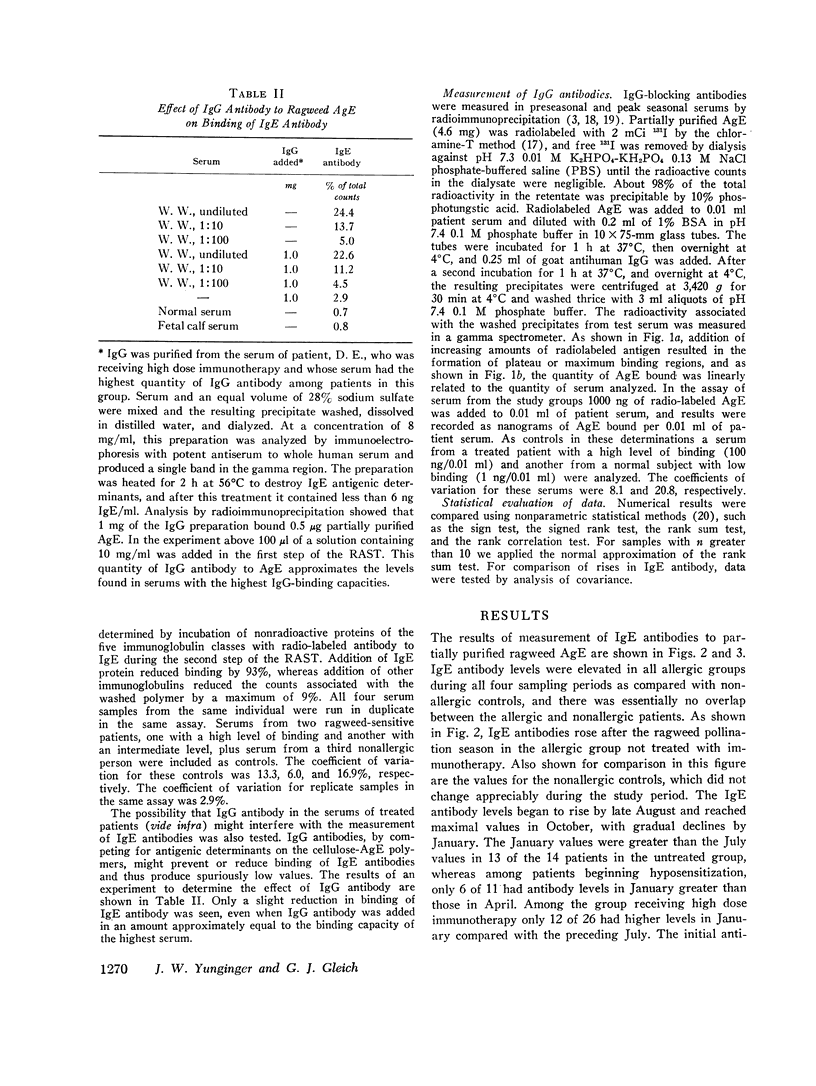
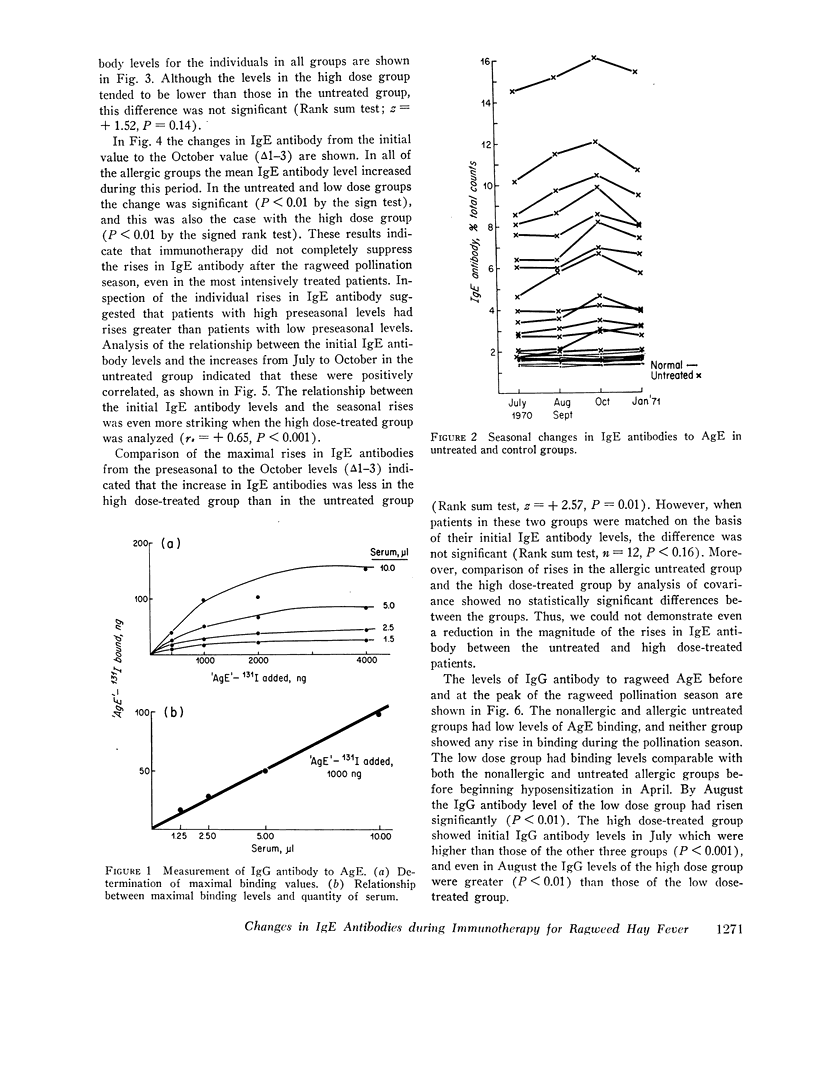
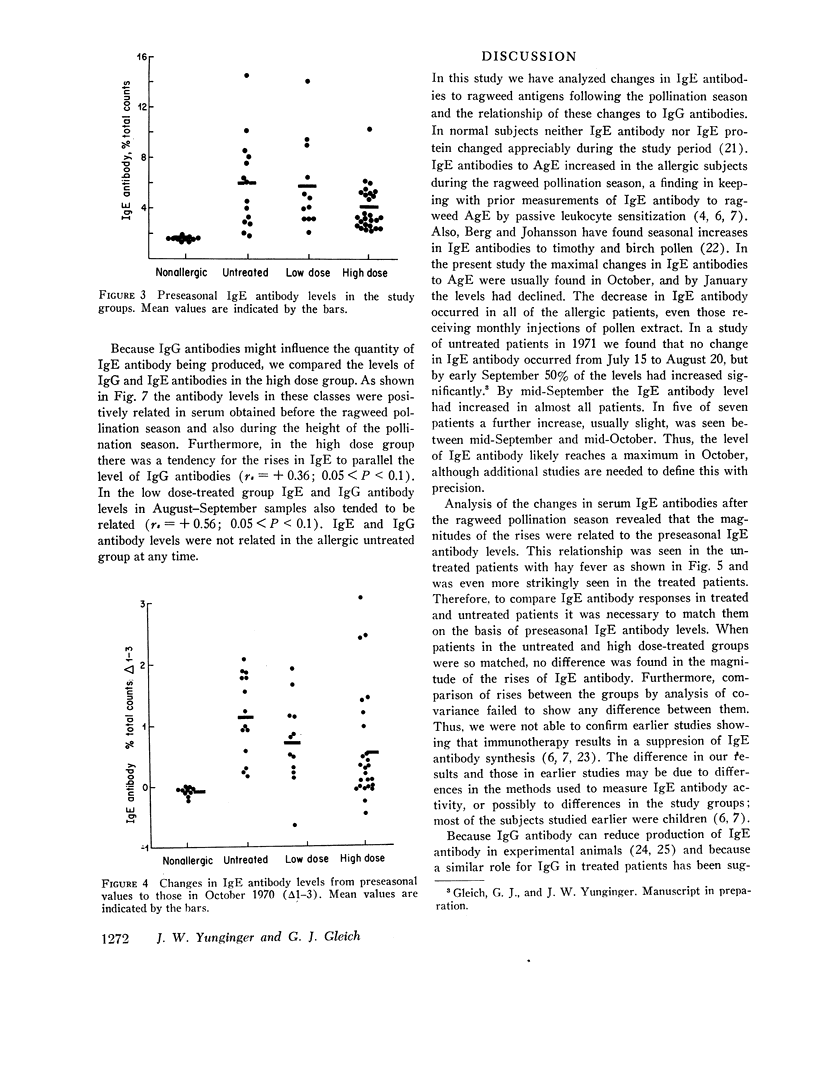
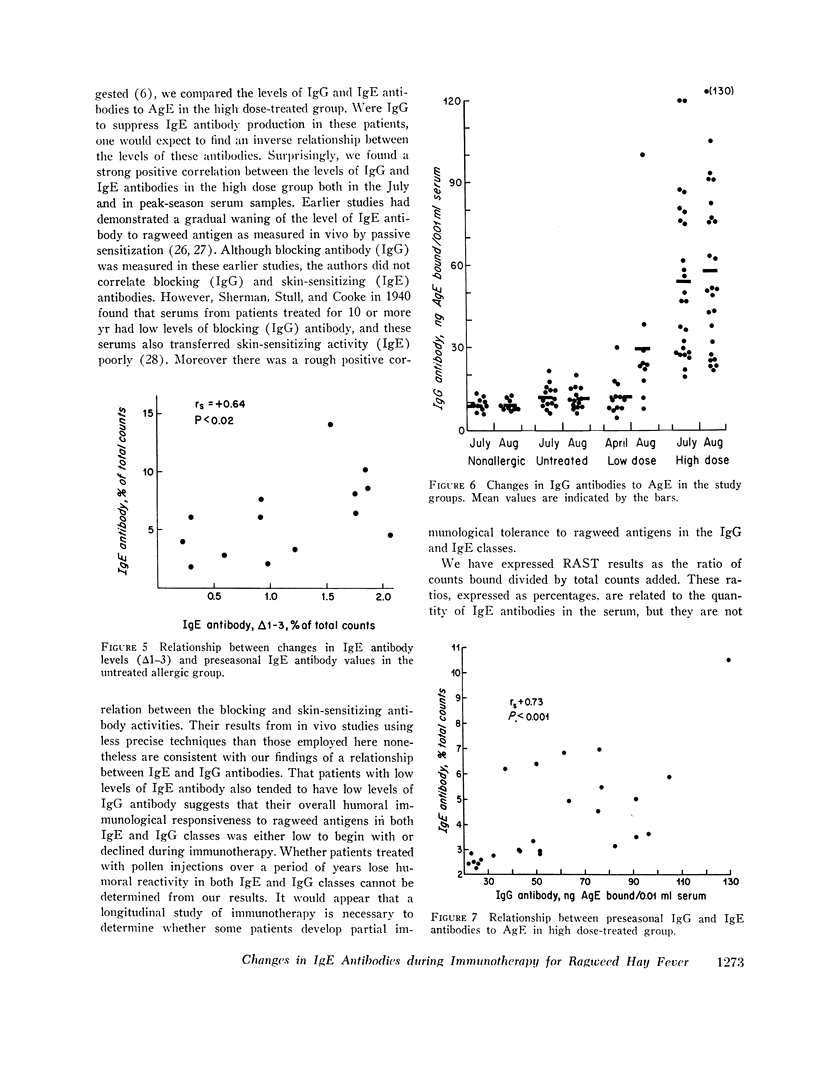
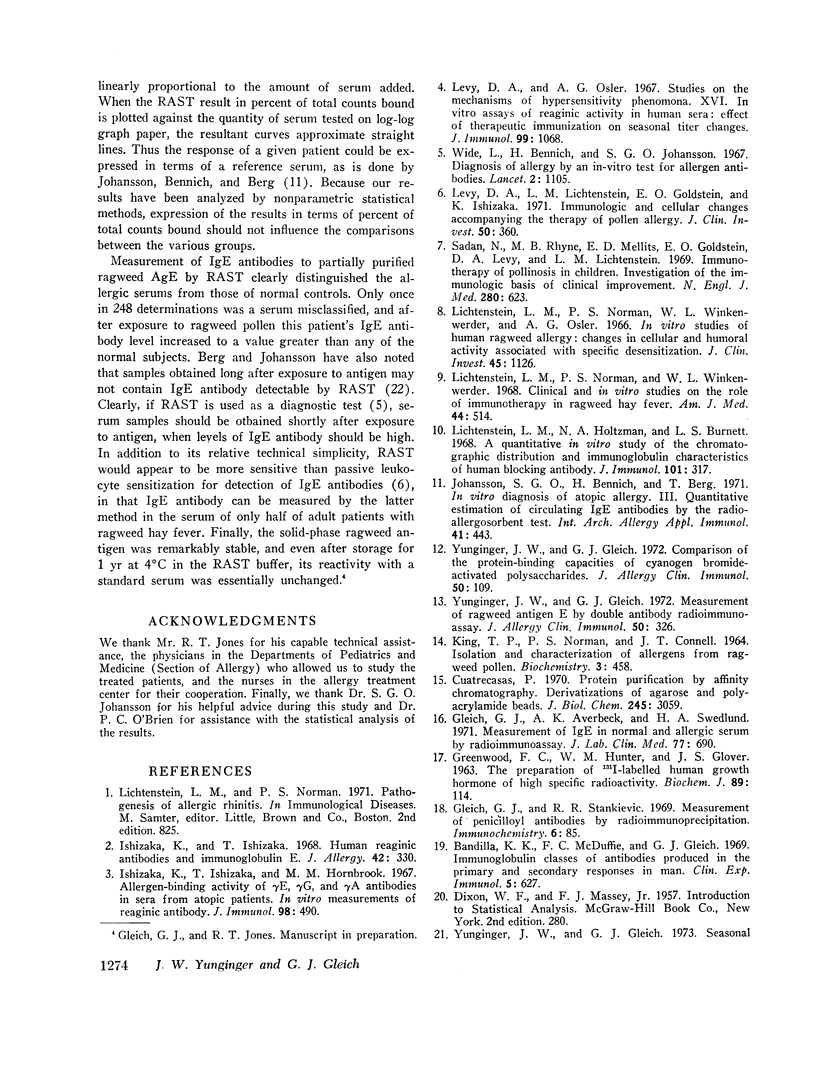
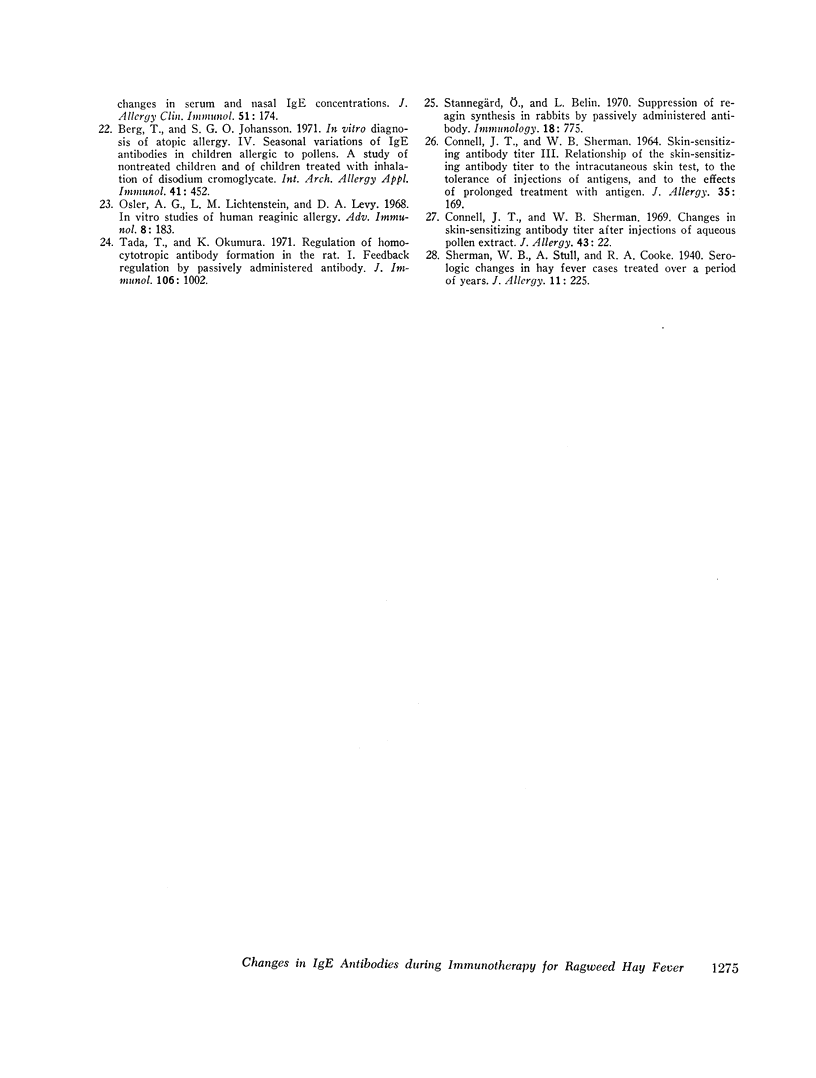
Selected References
These references are in PubMed. This may not be the complete list of references from this article.
- Bandilla K. K., McDuffie F. C., Gleich G. J. Immunoglobulin classes of antibodies produced in the primary and secondary responses in man. Clin Exp Immunol. 1969 Dec;5(6):627–641. [PMC free article] [PubMed] [Google Scholar]
- Berg T., Johansson S. G. In vitro diagnosis of atopic allergy. IV. Seasonal variations of IgE antibodies in children allergic to pollens. Int Arch Allergy Appl Immunol. 1971;41(2):452–462. [PubMed] [Google Scholar]
- CONNELL J. T., SHERMAN W. B. SKIN-SENSITIZING ANTIBODY TITER. III. RELATIONSHIP OF THE SKIN-SENSITIZING ANTIBODY TITER TO THE INTRACUTANEOUS SKIN TEST, TO THE TOLERANCE OF INJECTIONS OF ANTIGENS, AND TO THE EFFECTS OF PROLONGED TREATMENT WITH ANTIGEN. J Allergy. 1964 Mar-Apr;35:169–176. doi: 10.1016/0021-8707(64)90031-0. [DOI] [PubMed] [Google Scholar]
- Connell J. T., Sherman W. B. Changes in skin-sensitizing antibody titer after injections of aqueous pollen extract. J Allergy. 1969 Jan;43(1):22–32. doi: 10.1016/0021-8707(69)90017-3. [DOI] [PubMed] [Google Scholar]
- Cuatrecasas P. Protein purification by affinity chromatography. Derivatizations of agarose and polyacrylamide beads. J Biol Chem. 1970 Jun;245(12):3059–3065. [PubMed] [Google Scholar]
- GREENWOOD F. C., HUNTER W. M., GLOVER J. S. THE PREPARATION OF I-131-LABELLED HUMAN GROWTH HORMONE OF HIGH SPECIFIC RADIOACTIVITY. Biochem J. 1963 Oct;89:114–123. doi: 10.1042/bj0890114. [DOI] [PMC free article] [PubMed] [Google Scholar]
- Gleich G. J., Averbeck A. K., Swedlund H. A. Measurement of IgE in normal and allergic serum by radioimmunoassay. J Lab Clin Med. 1971 Apr;77(4):690–698. [PubMed] [Google Scholar]
- Gleich G. J., Stankievic R. R. Measurement of penicilloyl antibodies by radioimmunoprecipitation. Immunochemistry. 1969 Jan;6(1):85–99. doi: 10.1016/0019-2791(69)90181-5. [DOI] [PubMed] [Google Scholar]
- Ishizaka K., Ishizaka T., Hornbrook M. M. Allergen-binding activity of gamma-E, gamma-G and gamma-A antibodies in sera from atopic patients. In vitro measurements of reaginic antibody. J Immunol. 1967 Mar;98(3):490–501. [PubMed] [Google Scholar]
- Ishizaka K., Ishizaka T. Human reaginic antibodies and immunoglobulin E. J Allergy. 1968 Dec;42(6):330–363. doi: 10.1016/0021-8707(68)90095-6. [DOI] [PubMed] [Google Scholar]
- Johansson S. G., Bennich H., Berg T. In vitro diagnosis of atopic allergy. 3. Quantitative estimation of circulating IgE antibodies by the radioallergosorbent test. Int Arch Allergy Appl Immunol. 1971;41(2):443–451. [PubMed] [Google Scholar]
- KING T. P., NORMAN P. S., CONNELL J. T. ISOLATION AND CHARACTERIZATION OF ALLERGENS FROM RAGWEED POLLEN. II. Biochemistry. 1964 Mar;3:458–468. doi: 10.1021/bi00891a026. [DOI] [PubMed] [Google Scholar]
- Levy D. A., Lichtenstein L. M., Goldstein E. O., Ishizaka K. Immunologic and cellular changes accompanying the therapy of pollen allergy. J Clin Invest. 1971 Feb;50(2):360–369. doi: 10.1172/JCI106503. [DOI] [PMC free article] [PubMed] [Google Scholar]
- Levy D. A., Osler A. G. Studies on the mechanisms of hypersensitivity phenomena. XVI. In vitro assays of reaginic activity in human sera: effect of therapeutic immunization on seasonal titer changes. J Immunol. 1967 Dec;99(6):1068–1077. [PubMed] [Google Scholar]
- Lichtenstein L. M., Holtzman N. A., Burnett L. S. A quantitative in vitro study of the chromatographic distribution and immunoglobulin characteristics of human blocking antibody. J Immunol. 1968 Aug;101(2):317–324. [PubMed] [Google Scholar]
- Lichtenstein L. M., Norman P. S., Winkenwerder W. L. Clinical and in vitro studies on the role of immunotherapy in ragweed hay fever. Am J Med. 1968 Apr;44(4):514–524. doi: 10.1016/0002-9343(68)90052-1. [DOI] [PubMed] [Google Scholar]
- Lichtenstein L. M., Norman P. S., Winkenwerder W. L., Osler A. G. In vitro studies of human ragweed allergy: changes in cellular and humoral activity associated with specific desensitization. J Clin Invest. 1966 Jul;45(7):1126–1136. doi: 10.1172/JCI105419. [DOI] [PMC free article] [PubMed] [Google Scholar]
- Osler A. G., Lichtenstein L. M., Levy D. A. In vitro studies of human reaginic allergy. Adv Immunol. 1968;8:183–231. doi: 10.1016/s0065-2776(08)60467-8. [DOI] [PubMed] [Google Scholar]
- Sadan N., Rhyne M. B., Mellits E. D., Goldstein E. O., Levy D. A., Lichtenstein L. M. Immunotherapy of pollinosis in children: investigation of the immunologic basis of clinical improvement. N Engl J Med. 1969 Mar 20;280(12):623–627. doi: 10.1056/NEJM196903202801201. [DOI] [PubMed] [Google Scholar]
- Strannegård O., Belin L. Suppression of reagin synthesis in rabbits by passively administered antibody. Immunology. 1970 May;18(5):775–785. [PMC free article] [PubMed] [Google Scholar]
- Tada T., Okumura K. Regulation of homocytotropic antibody formation in the rat. I. Feed-back regulation by passively administered antibody. J Immunol. 1971 Apr;106(4):1002–1011. [PubMed] [Google Scholar]
- Wide L., Bennich H., Johansson S. G. Diagnosis of allergy by an in-vitro test for allergen antibodies. Lancet. 1967 Nov 25;2(7526):1105–1107. doi: 10.1016/s0140-6736(67)90615-0. [DOI] [PubMed] [Google Scholar]
- Yunginger J. W., Gleich G. J. Comparison of the protein-binding capacities of cyanogen bromide-activated polysaccharides. J Allergy Clin Immunol. 1972 Aug;50(2):109–116. doi: 10.1016/0091-6749(72)90006-1. [DOI] [PubMed] [Google Scholar]
- Yunginger J. W., Gleich G. J. Measurement of ragweed antigen E by double antibody radioimmunoassay. J Allergy Clin Immunol. 1972 Dec;50(6):326–337. doi: 10.1016/0091-6749(72)90036-x. [DOI] [PubMed] [Google Scholar]
- Yunginger J. W., Gleich G. J. Seasonal changes in serum and nassal IgE concentrations. J Allergy Clin Immunol. 1973 Mar;51(3):174–186. doi: 10.1016/0091-6749(73)90022-5. [DOI] [PubMed] [Google Scholar]


